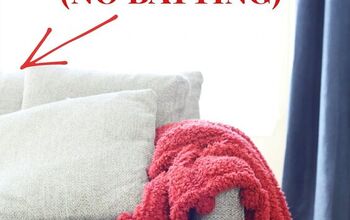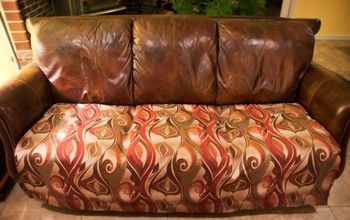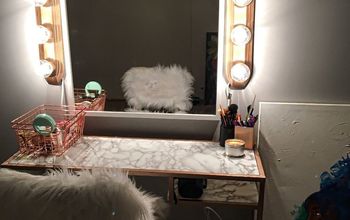How to Restuff Couch Cushions and Bring Them Back to Life

By Alexa Erickson
Over time, the filling in your couch cushions is bound to break down, no matter what the couch is made of. It’s natural for couches to sag over time, especially those that get a lot of use. Luckily, there’s no need to invest in a new one; the couch you have is still functional, and the best way to get it back to looking and feeling its best is to change out its cushions' filling every few years.
There are various materials to consider when restuffing the existing back and seat cushions on a couch, which we’ll cover in this guide. Let’s get that couch back to its best self!
Photo via The DIY Playbook
What Are Couch Cushions Filled With?
Couch cushions can be filled with different things, but the most popular material is foam. The best foam is one labeled "high-resilient density," or HR, and is the couch material most resilient to wear and sagging.
Feather-filled cushions are sought after by those who like the softness that feathers provide. Couches are typically filled with duck or chicken feathers, but the more expensive option is down, which is made up of the feathers on the underbellies of geese. You can also fill a couch cushion with any combination of feather types, but down material typically lasts longer than traditional feathers.
Polyester filling is a budget-friendly option that’s also great for those who have feather allergies. It’s available in several densities, though the best option is cluster-polyester cushions, which consist of tiny balls of fiber that are known very durable and long-lasting.
How to Check Existing Couch Filling
How to Measure Couch Cushions for Restuffing
First, you’ll measure the old cushions on your couch to help determine how much stuffing you’ll need for your new cushion filling. Prior to and while measuring your couch, be on the lookout for any holes or loosened threads that need repair before restuffing, and patch those up first. Also, be sure to measure every cushion—even if they all look the same size, very slight size differences in couch cushions do exist.
Step 1: Measure Width
Lay the cushion(s) on a flat surface. Use a sewing measuring tape to measure across the center of each couch cushion from right to left. Write down the measurements.
Step 2: Measure Depth
Measure from top to bottom at the center of each cushion. Write down the measurements.
Step 3: Measure Thickness/Height
Flip the cushion on its side and measure back to front at the center of each cushion. Write down the measurements.
Step 4: Add One Inch to Every Measurement
Add one inch to all of your charted measurements. This way, you'll ensure that the stuffing squeezes into every minuscule area of the space so there are no gaps.
Photo via Morgan McBride
How to Restuff Couch Cushions with Poly-Fil, Foam, and Batting
The most common process of restuffing couch cushions involves stuffing the back cushions with poly-fil, and stuffing the seat cushions with foam wrapped in batting. While the foam gives the cushion firmness and shape, batting will smooth it out and give the cushion more of that soft, cushy feeling.
Tools and Materials Needed
- Trash bag
- 10 pounds poly-fil
- Foam inserts in standard sofa cushion size (you'll cut to size)
- Utility knife
- 8 yards of quilt batting
- Spray adhesive
Step 1: Remove Back Cushions
Remove the cushions on the back of your couch. If there are covers, remove those as well.
Step 2: Restuff Back Cushions With Poly-fil
Unzip the cushion. Remove the current poly-fil and place them in a trash bag to dispose of later. Then, grab a handful of new poly-fil and shove it inside the cushion. Fill every inch, making sure you get to the corners of the cushion. Don’t be afraid to overstuff—a too-full cushion is better than a too-flat cushion! Once it’s fully stuffed, zip up the cushion and smooth out the material. Repeat with all back cushions.
Step 3: Remove Seat Cushions
Once you have stuffed all of your couch back cushions, it’s time to move onto the seat cushions. Use foam instead of poly-fil for the seat cushions, since they tend to be more flat than the back cushions, making them ideal for sitting on. Unzip your old cushions and remove the piece of foam from each; it will likely be wrapped with batting. Place the old piece aside for later disposal.
Step 4: Measure and Cut Foam
Use a utility knife to cut the foam pieces to the couch seat measurements you took in the "How to Measure Couch Cushions for Restuffing" section of this guide.
Step 5: Wrap New Foam With Batting
Unravel a roll of quilt batting a few times and lay it out on a surface. Place the cut foam cushion on top of it. Wrap the batting around the cushion (about three layers of batting should suffice). Use a spray adhesive to secure the batting to the foam.
Step 5: Restuff Seat Cushions
Stuff the new foam wrapped in batting into each cushion cover. The new cushions will likely be very snug in the covers—don’t be afraid to use a little elbow grease to get the cushions inside. Zip up the covers as you insert each cushion.
How to Restuff Couch Cushions with Down and Feathers
Next, we’ll show you how to restuff couch cushions with down and feathers. For this, you don’t necessarily need to buy completely new down or feathers; for the most part, restuffing might just mean taking the filling out of the cushions, fluffing them up a bit, and restuffing back into the couch. Regardless, the process of restuffing is pretty much the same.
Consider Combining Down and Feathers
Tools and Materials Needed
- Trash bags
- Seam ripper
- Goose or duck feathers
- Needle
- Thread
Step 1: Remove the Down-Filled Insert and Feathers
Open the zipper on the back of the couch cushion and pull out the down-filled insert. Use a seam ripper on the hand-sewn side of the insert to remove the stitches, gently cutting the threads. Use your hands to keep the insert closed as you place it inside a trash bag. Close the bag and shake it to allow the down and feathers to empty into the bag. This will also fluff up the down and feathers. Add new down and feathers if needed.
Step 2: Add Fluffed Down and Feathers to the Fabric Insert
Fill the insert to the brim with the new or re-fluffed down, feathers, or combination of the two. Hand-stitch the edge seam of the insert with a simple needle and thread.
Step 3: Place Insert Into Cushion Cover
Place the insert into the cushion cover. Zip the cushion cover and replace the cushion on the couch. To keep the cushions fluffier for longer, plan to shake them regularly to evenly distribute the filling.
What are your couch cushions filled with? Have you ever restuffed them yourself?

























Frequently asked questions
Have a question about this project?
When wrapping the foam with batting, is it 3 layers total or 3 layers each side?
How do you fix sagging arms of the couch?